Kirby Larson's Blog, page 5
January 12, 2015
Monday Musings
Why is it that I get utterly inpatient waiting for an editorial letter but when I get it, I can't make myself read it for a day or two?
 See that scary paper clip? That indicates the attached editorial letter
See that scary paper clip? That indicates the attached editorial letter
Another mystery of the writing life!
 See that scary paper clip? That indicates the attached editorial letter
See that scary paper clip? That indicates the attached editorial letterAnother mystery of the writing life!
Published on January 12, 2015 10:10
January 9, 2015
Friend Friday
Loralee Leavitt is a return guest for Friend Friday -- all because instead of eating all the candy that comes into her house, she goes all mad scientist on it. I think there's a lesson to be learned there! Welcome, Loralee.
 Loraless Leavitt
Loraless Leavitt
“Mom, what would happen if I put my Nerds in water?” This question, asked by my four-year-old daughter, launched our family into years of crazy candy experiments. We were so excited to share the fun that we created a website at www.candyexperiments.com, taught kids our experiments at national science fairs, and published a book, Candy Experiments.

After the book came out, I thought I might be done with candy experiments. After all, I’d already dissolved candy, smashed candy, microwaved candy, melted candy, frozen candy, and destroyed candy in every other way I could think of. I’d sunk marshmallows, separated M&M brown into rainbows of color, turned gummi worms into gummi snakes, and made Pixy Stix crystals that seemed to explode out of their bowl. Was there more I could add?
For any writer, it’s the questions that lead the way. In fiction, I’ve chased questions like “How did all this scotch broom get to Spain?” “How can I write a ghost story without a ghost?” “What if the twelve dancing princesses were really basketball-playing princes?” When I’m writing about candy experiments, I try to solve problems like, “Why doesn’t the gummi frog float until it’s been in water for two days?” “How can I sever a piece of licorice without touching it?” “Why do Mentos make better geysers than any other kind of candy?” Each question leads to new research, and new solutions. In some ways, each question forms its own tiny story.
Even after my book was published, candy questions kept coming. If I skewered some different colored Peeps, would I get rainbow of sinking sugar dyes? (No.) If I froze Cadbury Eggs with dry ice, could I shatter them with a hammer? (Yes.) Why did chocolate turn a lighter color in water? What could I do with xylitol? What would Pop Rocks in the oven? In oil? In oil and water? I jotted my questions down on a list, and experimented occasionally. So, when my publisher requested a new book--and needed it soon--I was ready.
While my list of questions made a great starting point, new candy play led to new experiments. An experiment on dissolving candy in different solutions led to the surprising discovery that some red gummi worms turn blue in baking soda water. A bag of peach gummi rings left in a hot car melted into a solid mass with a layer of marshmallow on the top, from which I learned that I could heat a gummi ring and make it “flip over” without even touching it. When I microwaved a Twizzler’s licorice stick, warts popped out all over. Each crazy new discovery made me ask more questions, and want the answers!
As a mother of four kids, I worried that the book would be an impossible project. But I had a lot of help. My kids tried experiments for me, and were recruited as “hand models” in photos. A friend came over to help me record data and take photos, with each of us juggling a baby. My husband researched xylitol-water ratios to create a supersaturated solution that crystallized almost instantly when stirred. My dad photographed Mentos under a microscope to show the tiny pits where bubbles form in Mentos-Coke geysers. Meanwhile, I experimented, researched, and wrote like a madwoman. Somehow, it all came together on time.
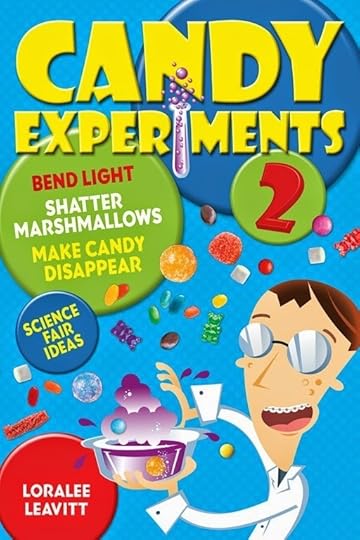
Even as I celebrate the publication of Candy Experiments 2, new questions pop up. Would a piece of “jiggler” finger jello absorb as much water as a gummi worm? Does dissolving candy in water affect the surface tension? Do different sodas have different surface tension? Could I sink something in soda that I can’t sink in water? How many more experiments are waiting for me?
After all, you never know where a question will lead.
Loralee Leavitt is the author of Candy Experiments and Candy Experiments 2, books of crazy experiments that help kids learn science as they destroy candy. Her four children are invaluable co-contributors. She is also the co-author of Road Tripping: A Parent's Guide to Planning and Surviving the Annual Car Trip.
 Loraless Leavitt
Loraless Leavitt
“Mom, what would happen if I put my Nerds in water?” This question, asked by my four-year-old daughter, launched our family into years of crazy candy experiments. We were so excited to share the fun that we created a website at www.candyexperiments.com, taught kids our experiments at national science fairs, and published a book, Candy Experiments.

After the book came out, I thought I might be done with candy experiments. After all, I’d already dissolved candy, smashed candy, microwaved candy, melted candy, frozen candy, and destroyed candy in every other way I could think of. I’d sunk marshmallows, separated M&M brown into rainbows of color, turned gummi worms into gummi snakes, and made Pixy Stix crystals that seemed to explode out of their bowl. Was there more I could add?
For any writer, it’s the questions that lead the way. In fiction, I’ve chased questions like “How did all this scotch broom get to Spain?” “How can I write a ghost story without a ghost?” “What if the twelve dancing princesses were really basketball-playing princes?” When I’m writing about candy experiments, I try to solve problems like, “Why doesn’t the gummi frog float until it’s been in water for two days?” “How can I sever a piece of licorice without touching it?” “Why do Mentos make better geysers than any other kind of candy?” Each question leads to new research, and new solutions. In some ways, each question forms its own tiny story.
Even after my book was published, candy questions kept coming. If I skewered some different colored Peeps, would I get rainbow of sinking sugar dyes? (No.) If I froze Cadbury Eggs with dry ice, could I shatter them with a hammer? (Yes.) Why did chocolate turn a lighter color in water? What could I do with xylitol? What would Pop Rocks in the oven? In oil? In oil and water? I jotted my questions down on a list, and experimented occasionally. So, when my publisher requested a new book--and needed it soon--I was ready.
While my list of questions made a great starting point, new candy play led to new experiments. An experiment on dissolving candy in different solutions led to the surprising discovery that some red gummi worms turn blue in baking soda water. A bag of peach gummi rings left in a hot car melted into a solid mass with a layer of marshmallow on the top, from which I learned that I could heat a gummi ring and make it “flip over” without even touching it. When I microwaved a Twizzler’s licorice stick, warts popped out all over. Each crazy new discovery made me ask more questions, and want the answers!
As a mother of four kids, I worried that the book would be an impossible project. But I had a lot of help. My kids tried experiments for me, and were recruited as “hand models” in photos. A friend came over to help me record data and take photos, with each of us juggling a baby. My husband researched xylitol-water ratios to create a supersaturated solution that crystallized almost instantly when stirred. My dad photographed Mentos under a microscope to show the tiny pits where bubbles form in Mentos-Coke geysers. Meanwhile, I experimented, researched, and wrote like a madwoman. Somehow, it all came together on time.

Even as I celebrate the publication of Candy Experiments 2, new questions pop up. Would a piece of “jiggler” finger jello absorb as much water as a gummi worm? Does dissolving candy in water affect the surface tension? Do different sodas have different surface tension? Could I sink something in soda that I can’t sink in water? How many more experiments are waiting for me?
After all, you never know where a question will lead.
Loralee Leavitt is the author of Candy Experiments and Candy Experiments 2, books of crazy experiments that help kids learn science as they destroy candy. Her four children are invaluable co-contributors. She is also the co-author of Road Tripping: A Parent's Guide to Planning and Surviving the Annual Car Trip.
Published on January 09, 2015 05:30
January 6, 2015
Teacher Tuesday
Welcome to the first Teacher Tuesday of 2015! Kicking off the year is Kimmie Vogt, a self described teacher, librarian and technology fixer. Thanks for playing, Kimmie!
Please fill in the blank: You should never read and (blank) at the same time.
You should never read and drive on the interstate at the same time. Listen to books while driving. Much safer.
If you were invited to be on Oprah, what book would you bring for her to read?
Life is a Verb by Patti Digh
What is the funniest book you’ve read?
Skinny Dip by Carl Hiassen
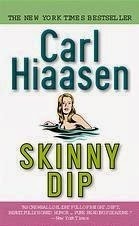
What is the saddest?
Fault In Our Stars by John Green
Favorite reading snack/beverage?
Decaf Breakfast blend Green Mountain Coffee with French Vanilla Creamer
What’s next on your TBR list?

My list/pile is pretty deep right now. It includes: Landline by Rainbow Rowell, Marie Lu's latest, The Girls of Kabul, The Historian, Cinder and Variant. In between cuddling, feeding, singing and oodling a newborn--I am trying to continue reading so my students and I can have relevant reading conversations when I get back to them in January.
Teachers, librarians, reading coaches, principals, custodians, lunch ladies, anyone with school connections: Please play along! Email me here and I'll get you the questions so you, too, can be featured on Teacher Tuesday.
Please fill in the blank: You should never read and (blank) at the same time.
You should never read and drive on the interstate at the same time. Listen to books while driving. Much safer.
If you were invited to be on Oprah, what book would you bring for her to read?
Life is a Verb by Patti Digh
What is the funniest book you’ve read?
Skinny Dip by Carl Hiassen

What is the saddest?
Fault In Our Stars by John Green
Favorite reading snack/beverage?
Decaf Breakfast blend Green Mountain Coffee with French Vanilla Creamer
What’s next on your TBR list?

My list/pile is pretty deep right now. It includes: Landline by Rainbow Rowell, Marie Lu's latest, The Girls of Kabul, The Historian, Cinder and Variant. In between cuddling, feeding, singing and oodling a newborn--I am trying to continue reading so my students and I can have relevant reading conversations when I get back to them in January.
Teachers, librarians, reading coaches, principals, custodians, lunch ladies, anyone with school connections: Please play along! Email me here and I'll get you the questions so you, too, can be featured on Teacher Tuesday.
Published on January 06, 2015 05:30
December 31, 2014
Wednesday Wisdom
In order to be irreplaceable, one must always be different.
Coco Chanel
Coco Chanel
Published on December 31, 2014 05:30
December 24, 2014
Wednesday Wisdom
The stories we love best do live in us forever.
J.K. Rowling
J.K. Rowling
Published on December 24, 2014 05:30
December 22, 2014
Happy Holidays
I am taking the next few weeks off from my blog to spend time with my family: niece Holli is home (finally!) after many years down under in Australia; my folks are enjoying good health after a rough few years; and there will be some new faces around the Christmas tree, including my great-niece Blakely, and our new San Francisco family, Audrey, Eli and Nicole.
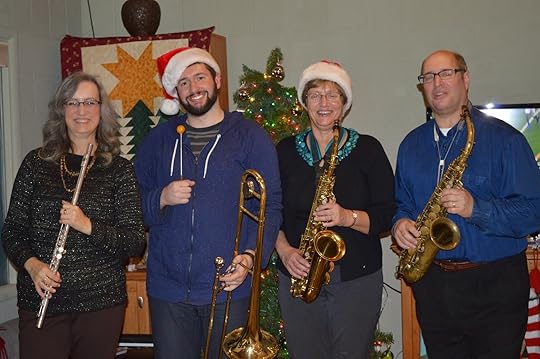 the 2014 Larson Family Annual Christmas Concert crew
the 2014 Larson Family Annual Christmas Concert crew
The year has held its ups and downs for me; I'm sure it has for you, too. I'm counting on the year ending on a note of joy (and gingerbread!) and look forward to a new year brimming with promise and peace.
See you in 2015!
 the 2014 Larson Family Annual Christmas Concert crew
the 2014 Larson Family Annual Christmas Concert crewThe year has held its ups and downs for me; I'm sure it has for you, too. I'm counting on the year ending on a note of joy (and gingerbread!) and look forward to a new year brimming with promise and peace.
See you in 2015!
Published on December 22, 2014 05:30
December 19, 2014
Friend Friday
This is the last Friend Friday post of 2014 -- we'll start the feature up again on January 9, 2015. Today, however, we are going to the dogs. . .Stacy Nyikos' dogs, that is. Well, dog singular. But Desi lives large in every way and his zest for life (and trouble) has inspired Stacy's newest picture book.
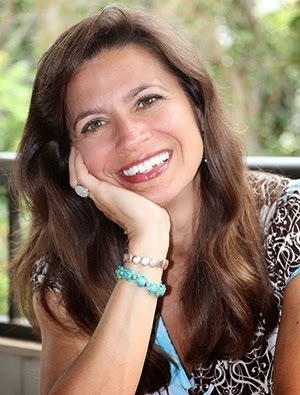 Stacy Nyikos
Stacy Nyikos
My latest book, Waggers (2 December 2014, Sky Pony Press), is about a newly adopted puppy who tries REALLY hard to be good, but his tail get in the way.
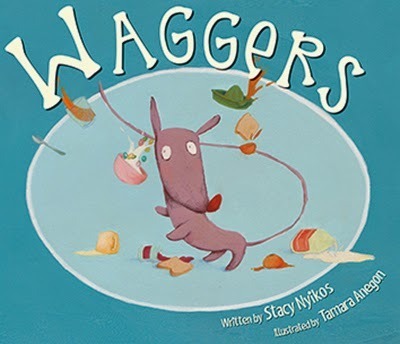
The story was inspired by unexpected, definitely unintended, but sometimes unbelievably disastrous mishaps by our most recently adopted puppy, Desi, who has the heart of a Great Dane and the tail of a Great White Whale.

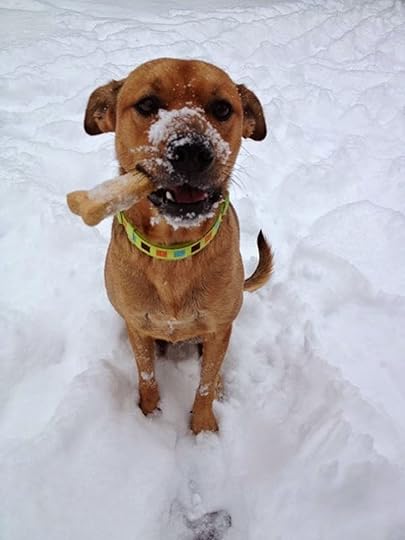
It was a fun write, cathartic even, but every story challenges me in some way. With Waggers, it was originality.
Story itself isn’t exactly original. In fact, if you want a blueprint for it, take a look at Joseph Campbell A Hero’s Journey. He takes an Emperor’s New Clothes approach to story, revealing all its unseemly parts. No page is unturned, no trick unmasked.
Neither is telling story. A lot of our communication takes on story format. How was your day? What happened at school? How is the project coming along?
Of course, the answer can be a single sentence (with my teen daughters, a grunt), but more often than not, we listeners ask for more, until we’ve got beginning, middle, and end. For better or worse, we like our information in a certain form.
Here’s the trick. A storyteller can’t just reuse an already used form without adding her own flair. If she does, things become predictable and the reader goes off to make a cheese sandwich, never to return. Readers want to be surprised. They want unusual. But how do you take the everyday and make it new and out-of-the-ordinary? That’s what I faced with Waggers. A dog with a problem isn’t novel. I was going to have to get creative.
Pause for dramatic effect.
Not affected? Dare I say, this is what you expect of writers, that they are creative, imaginative, avant-garde even? Demanding readers. Okay, okay, me too. I expect the seemingly impossible of writers, and my writing.
Yet with Waggers, I seesawed between something so new it couldn’t even be called story, to something so trite I was falling asleep. So I tried the demented writer approach – i.e. ditch everything, kill my darlings – until I didn’t even have enough left to call a haiku. Which brought me to the sobering realization that this was about balance. It was about sifting through and discovering what elements I could use and how to reshape, relay, reimagine and add until my story emerged with its own form and flair.
I wish I could say I understood all of that when I was going through it, but I am a messy writer. I never know exactly where I am until I finish and step back to get my bearings. If I don’t recognize my surroundings, woohoo! I’ve taken story somewhere new.
Now if I can just sell it…
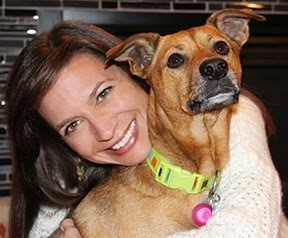
About the Author: Stacy Nyikos is the author of many mischievous books for kids. She's not sure how that happened. She never got into trouble as a child. Well, if you don't count borrowing sandwiches from her dad. He wasn't eating them anyway. She holds an MFA in Writing for Children from Vermont College, which she didn't borrow. They gave it to her. Really. Ask her kids. Or her dog. Just don't ask her husband. He's missing a few sandwiches.
 Stacy Nyikos
Stacy NyikosMy latest book, Waggers (2 December 2014, Sky Pony Press), is about a newly adopted puppy who tries REALLY hard to be good, but his tail get in the way.

The story was inspired by unexpected, definitely unintended, but sometimes unbelievably disastrous mishaps by our most recently adopted puppy, Desi, who has the heart of a Great Dane and the tail of a Great White Whale.


It was a fun write, cathartic even, but every story challenges me in some way. With Waggers, it was originality.
Story itself isn’t exactly original. In fact, if you want a blueprint for it, take a look at Joseph Campbell A Hero’s Journey. He takes an Emperor’s New Clothes approach to story, revealing all its unseemly parts. No page is unturned, no trick unmasked.
Neither is telling story. A lot of our communication takes on story format. How was your day? What happened at school? How is the project coming along?
Of course, the answer can be a single sentence (with my teen daughters, a grunt), but more often than not, we listeners ask for more, until we’ve got beginning, middle, and end. For better or worse, we like our information in a certain form.
Here’s the trick. A storyteller can’t just reuse an already used form without adding her own flair. If she does, things become predictable and the reader goes off to make a cheese sandwich, never to return. Readers want to be surprised. They want unusual. But how do you take the everyday and make it new and out-of-the-ordinary? That’s what I faced with Waggers. A dog with a problem isn’t novel. I was going to have to get creative.
Pause for dramatic effect.
Not affected? Dare I say, this is what you expect of writers, that they are creative, imaginative, avant-garde even? Demanding readers. Okay, okay, me too. I expect the seemingly impossible of writers, and my writing.
Yet with Waggers, I seesawed between something so new it couldn’t even be called story, to something so trite I was falling asleep. So I tried the demented writer approach – i.e. ditch everything, kill my darlings – until I didn’t even have enough left to call a haiku. Which brought me to the sobering realization that this was about balance. It was about sifting through and discovering what elements I could use and how to reshape, relay, reimagine and add until my story emerged with its own form and flair.
I wish I could say I understood all of that when I was going through it, but I am a messy writer. I never know exactly where I am until I finish and step back to get my bearings. If I don’t recognize my surroundings, woohoo! I’ve taken story somewhere new.
Now if I can just sell it…

About the Author: Stacy Nyikos is the author of many mischievous books for kids. She's not sure how that happened. She never got into trouble as a child. Well, if you don't count borrowing sandwiches from her dad. He wasn't eating them anyway. She holds an MFA in Writing for Children from Vermont College, which she didn't borrow. They gave it to her. Really. Ask her kids. Or her dog. Just don't ask her husband. He's missing a few sandwiches.
Published on December 19, 2014 05:30
December 17, 2014
Wednesday Wisdom
I have nothing against work, particularly when performed quietly and unobtrusively by someone else.
Barbara Ehrenreich
Barbara Ehrenreich
Published on December 17, 2014 05:30
December 16, 2014
Teacher Tuesday
Thanks to Alex Valencic for being my guest today. Alex is a self-described professional educator and literature enthusiast who shares his passion for books with 4th graders in Urbana, Illinois.
Alex, please fill in the blank:You should never read and (blank) at the same time.
You should never read and sleep at the same time. You end up waking up trying to figure out why you have turned 20 pages in your book but don't remember anything from them!
If you were invited to be on Oprah, what book would you bring for her to read?
If I were invited to be on Oprah, I would bring her Kathryn Otoshi's series of books with numbers as the titles. (Currently Zero, One, and Two. They are simple picture books but they teach important life lessons about standing up for what's right, including others, and making sure everyone knows they are important!
What is the funniest book you’ve read?
I have read far too many books to pick one as the funniest, but one of the funniest books I have read recently is definitely Goldilocks and the Three Dinosaurs by Mo Willems. I read it to my five-year-old cousin over the summer and she and I were giggling uncontrollably the whole time!
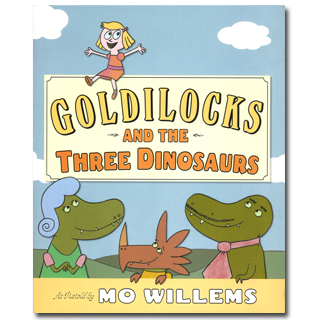
What is the saddest?
I somehow manage to read a lot of sad books, or, at least, books with sad parts. (I don't think I've ever read a book that was just straight-up sad.) However, I have to admit that I felt like a horrible monster when I read the saddest part of Hattie Big Sky to my fourth graders (nope, not gonna give any spoilers) right before a long weekend! I had several of my students in tears and several more who yelled at me for leaving at that point!
Favorite reading snack/beverage?
I admit: in addition to being a bibliophile, I am an chocoholic. Give me a bag of chocolate and a book and I'll be happy as a clam! Oh, and I won't complain if you hand me a bottle of Dr. Pepper, Cherry Coke, or any type of ginger ale.
What’s next on your TBR list?
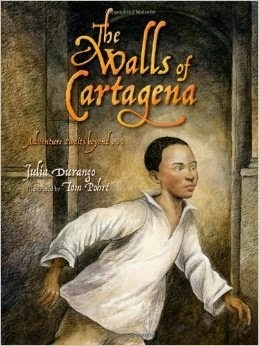
I have several lists, actually. Um, I guess I'll keep my responses limited to my children's book list. Next up is The Walls of Cartagena by Illinois author Julia Durango, who I met at a children's writing conference last May. I'm planning on using it during my unit on European exploration and colonization of the Americas. (Don't worry, Kirby; Duke and Dash are both in the pile!)
Thanks, Alex! I won't worry.
Teachers, librarians, reading coaches, principals, custodians, lunch ladies, anyone with school connections: Please play along! Email me here and I'll get you the questions so you, too, can be featured on Teacher Tuesday.
Alex, please fill in the blank:You should never read and (blank) at the same time.
You should never read and sleep at the same time. You end up waking up trying to figure out why you have turned 20 pages in your book but don't remember anything from them!
If you were invited to be on Oprah, what book would you bring for her to read?
If I were invited to be on Oprah, I would bring her Kathryn Otoshi's series of books with numbers as the titles. (Currently Zero, One, and Two. They are simple picture books but they teach important life lessons about standing up for what's right, including others, and making sure everyone knows they are important!
What is the funniest book you’ve read?
I have read far too many books to pick one as the funniest, but one of the funniest books I have read recently is definitely Goldilocks and the Three Dinosaurs by Mo Willems. I read it to my five-year-old cousin over the summer and she and I were giggling uncontrollably the whole time!

What is the saddest?
I somehow manage to read a lot of sad books, or, at least, books with sad parts. (I don't think I've ever read a book that was just straight-up sad.) However, I have to admit that I felt like a horrible monster when I read the saddest part of Hattie Big Sky to my fourth graders (nope, not gonna give any spoilers) right before a long weekend! I had several of my students in tears and several more who yelled at me for leaving at that point!
Favorite reading snack/beverage?
I admit: in addition to being a bibliophile, I am an chocoholic. Give me a bag of chocolate and a book and I'll be happy as a clam! Oh, and I won't complain if you hand me a bottle of Dr. Pepper, Cherry Coke, or any type of ginger ale.
What’s next on your TBR list?

I have several lists, actually. Um, I guess I'll keep my responses limited to my children's book list. Next up is The Walls of Cartagena by Illinois author Julia Durango, who I met at a children's writing conference last May. I'm planning on using it during my unit on European exploration and colonization of the Americas. (Don't worry, Kirby; Duke and Dash are both in the pile!)
Thanks, Alex! I won't worry.
Teachers, librarians, reading coaches, principals, custodians, lunch ladies, anyone with school connections: Please play along! Email me here and I'll get you the questions so you, too, can be featured on Teacher Tuesday.
Published on December 16, 2014 05:30
December 12, 2014
Friend Friday
Sometimes, I just plain don't recall how I met people and that's the case with Lee McKenzie but I am so very glad to host her today for Friend Friday. Take it away, Lee!

A Writer’s Journey
Writing is an interesting and unpredictable journey. When I started, I had no idea I’d be writing young and middle grade books. My only thought was, “I’d like to write something I would read.”
Mostly I enjoy writing realistic, contemporary young adult novels. However, a steady diet of tough issues teens face today leaves my writer’s well a little dry at times, so I like mixing it up when it comes to what I write.
Non-fiction articles are perfect for balance, and I’ve tackled everything from Vermiculture for kids to an article about a Tuatara. If you’re curious about either topic, click on its title below.
WORM TEA
HENRY IS A TUATARA
A couple of years ago, I took a leap into a middle grade fantasy adventure, Alligators Overhead. I loved writing the story about Pete Riley, the town rascal, and his sidekick, Weasel, while they saved an endangered wetlands. I loved it so much, I’ve just finished a sequel. This one’s The Great Time Lock Disaster. Once again the rascal and his bookish friend get into all kinds of trouble that I hope will delight young readers.
However, there is one story I want to write, but can’t seem to.
Why? I can write stories for beginning readers and teens; I’ve written and published fiction and non-fiction, so what’s stopping me from writing one story I really want to see come to the page?
You see the story is really my dad’s. It’s about his life as a boy who grew up in hardship. It tells about his struggle to leave behind a terrible boyhood and make a good life for himself. It tells about his years at the university on a scholarship, his marriage, his war years.
Maybe the reason I can’t finish it is he should have written it; then it would be right.
When he was alive, I worried what he’d say if he read how I set down the events he’d told me. What if I didn’t have them the way he wanted?
Since he’s gone, I hesitate because I think, well, he’s not here to correct me. I’m writing his life through my filter, and it could be all wrong.
I’ve obviously gone around on this issue. Finally, I’ve decided I’ll write it as a biography. I have no plans for publishing it, but I’d like it to be his “dash" fleshed out with the stories he told me during the years we shared.
Now I’ll have to learn a bit about writing biographies because, while I enjoy reading them, I know nothing about how to make them interesting enough to read.
Everyday I wonder where my writing journey will take me. Everyday I’m excited to wake up and see what will happen next.
Thanks for letting me stop by, Kirby. It’s such a pleasure to connect with you after so many years.
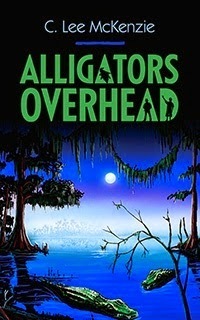
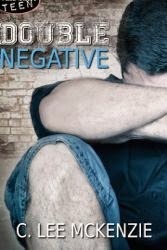
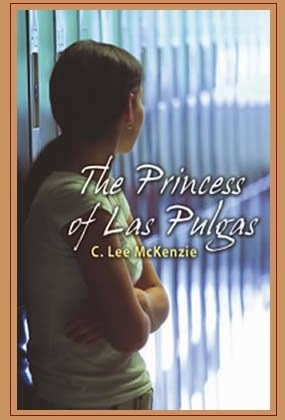
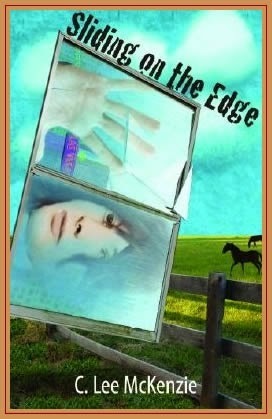
Lee is a native Californian who grew up in a lot of different places, then landed in the Santa Cruz Mountains where she lives with her family and miscellaneous pets. She writes most of the time, gardens, hikes and does yoga a lot. She also travels whenever she can.
In her writing, she takes on modern issues that today's teens face in their daily lives. Her first young adult novel, Sliding on the Edge, which dealt with cutting and suicide, was published in 2009. Her second, titled The Princess of Las Pulgas, dealing with a family who loses everything and must rebuild their lives, came out in 2010. Double Negative (2014) is her third young adult novel, and her fourth, Sudden Secrets, will be out soon.
In 2012, her first middle grade novel, Alligators Overhead, was published and she's just finished the sequel which she's calling The Great Time Lock Disaster.

A Writer’s Journey
Writing is an interesting and unpredictable journey. When I started, I had no idea I’d be writing young and middle grade books. My only thought was, “I’d like to write something I would read.”
Mostly I enjoy writing realistic, contemporary young adult novels. However, a steady diet of tough issues teens face today leaves my writer’s well a little dry at times, so I like mixing it up when it comes to what I write.
Non-fiction articles are perfect for balance, and I’ve tackled everything from Vermiculture for kids to an article about a Tuatara. If you’re curious about either topic, click on its title below.
WORM TEA
HENRY IS A TUATARA
A couple of years ago, I took a leap into a middle grade fantasy adventure, Alligators Overhead. I loved writing the story about Pete Riley, the town rascal, and his sidekick, Weasel, while they saved an endangered wetlands. I loved it so much, I’ve just finished a sequel. This one’s The Great Time Lock Disaster. Once again the rascal and his bookish friend get into all kinds of trouble that I hope will delight young readers.
However, there is one story I want to write, but can’t seem to.
Why? I can write stories for beginning readers and teens; I’ve written and published fiction and non-fiction, so what’s stopping me from writing one story I really want to see come to the page?
You see the story is really my dad’s. It’s about his life as a boy who grew up in hardship. It tells about his struggle to leave behind a terrible boyhood and make a good life for himself. It tells about his years at the university on a scholarship, his marriage, his war years.
Maybe the reason I can’t finish it is he should have written it; then it would be right.
When he was alive, I worried what he’d say if he read how I set down the events he’d told me. What if I didn’t have them the way he wanted?
Since he’s gone, I hesitate because I think, well, he’s not here to correct me. I’m writing his life through my filter, and it could be all wrong.
I’ve obviously gone around on this issue. Finally, I’ve decided I’ll write it as a biography. I have no plans for publishing it, but I’d like it to be his “dash" fleshed out with the stories he told me during the years we shared.
Now I’ll have to learn a bit about writing biographies because, while I enjoy reading them, I know nothing about how to make them interesting enough to read.
Everyday I wonder where my writing journey will take me. Everyday I’m excited to wake up and see what will happen next.
Thanks for letting me stop by, Kirby. It’s such a pleasure to connect with you after so many years.




Lee is a native Californian who grew up in a lot of different places, then landed in the Santa Cruz Mountains where she lives with her family and miscellaneous pets. She writes most of the time, gardens, hikes and does yoga a lot. She also travels whenever she can.
In her writing, she takes on modern issues that today's teens face in their daily lives. Her first young adult novel, Sliding on the Edge, which dealt with cutting and suicide, was published in 2009. Her second, titled The Princess of Las Pulgas, dealing with a family who loses everything and must rebuild their lives, came out in 2010. Double Negative (2014) is her third young adult novel, and her fourth, Sudden Secrets, will be out soon.
In 2012, her first middle grade novel, Alligators Overhead, was published and she's just finished the sequel which she's calling The Great Time Lock Disaster.
Published on December 12, 2014 05:30



